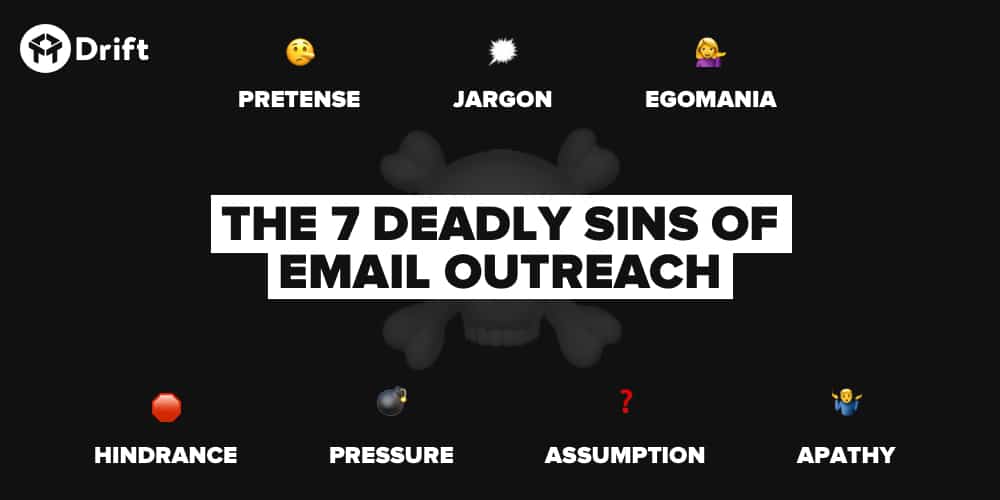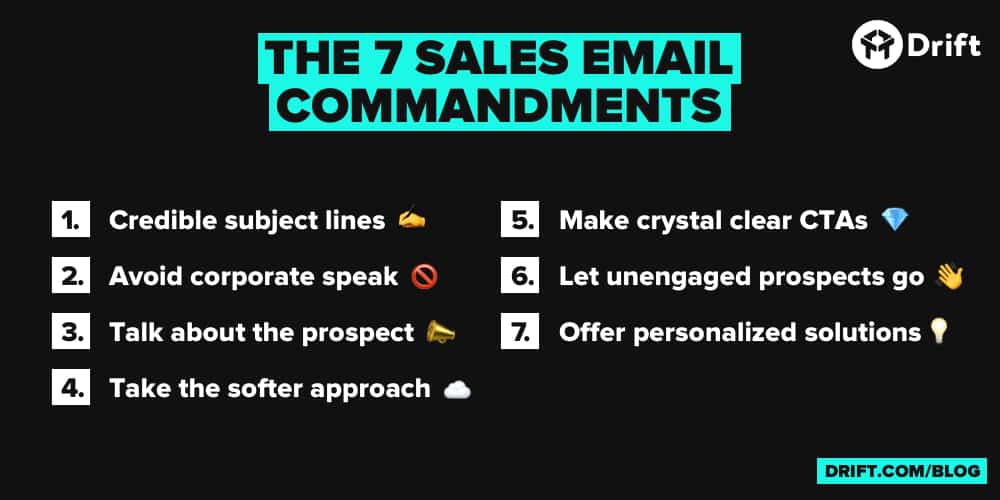
Take a minute to think about why you send cold sales emails. To spread the word about an offering? To build links? To share some news or prompt an action?
If there’s one goal all sales and marketing teams can agree on, it’s to start a conversation.
Now consider this: The average person receives 125 business emails a day. Even if you’re clear on campaign goals, your email won’t get eyeballs unless it cuts through the clutter. And in B2B, that’s only half the battle. Decision makers are numerous, informed, and strapped for time. They have to notice, open, skim, and draw value from your email before considering it worth their attention.
Tough crowd.
Hopefully, it’s all downhill from there. When you have it, attention leads to conversation, conversation to engagement, engagement to trust, and trust to sales.
But how do you get over that hump? Well, if you’re not committing the following sales email sins — and you’d be surprised how many businesses are — you’re already ahead of the game.
#1 — Pretense
Let’s start with the first thing your recipient sees: the subject line.
You know these 50 characters have to stand out, but not at the expense of clarity. The important thing is that they match the rest of the email’s intent.
The best way to tackle the subject line of an email is to think of it as the headline of a story, or the anchor that keeps the content grounded. Get too caught up making it catchy, and you’ll lose focus on your reader’s experience.
You know the kind: An “idea for your next project” that turns out to be a generic demo of a product. A “time-sensitive offer” that won’t be available for months. Or an “Re:” tacked on to make you think you’ve corresponded before.
Makes you feel a little cheated, doesn’t it?
So, after writing your sales email, read both subject line and body from your target’s POV. Does the email deliver on the subject line’s promise, or are you left feeling something is missing? Luring your recipients into the email with empty promises will put it on the fastest track to failure.
#2 — Jargon
Okay. Jargon isn’t always a deadly sin. It can work for:
- Connecting with a niche audience, like people in highly technical fields. In this case, jargon becomes terminology, or part of a secret language the audience will feel proud to be able to speak.
- Creating a sense of added value by making the ordinary seem extraordinary. Used becomes pre-owned, large becomes grande.
- Well-known acronyms, when they help keep things concise.
But these are exceptions to the rule. B2B companies often make the mistake of thinking they can engage recipients only with corporate speak. In reality, buzzwords put up unnecessary barriers when they inflate copy to make you seem smart. (They don’t.) The simple version wins out almost every time.
Rather than allow well-worn sales and marketing terms (we’re looking at you, ROI) to strip your email of meaning, go for words that come to your audience naturally. Use over utilize, end over terminate, receive over get, and so on. Read your email aloud to weed out anything that sounds pompous or awkward.
When it doubt, leave jargon out, explain it, or use the language your audience is using. Explore forums, social channels, and other online communities to see how they describe their pain points. The more familiar the words, the better their chances of making an impact.
#3 — Egomania
Not long ago, the following introduction hit my LinkedIn inbox (sender name changed, company details withheld, otherwise word for word):
Hi Adrienne,
Adam from [Company] calling! We are [Company], an international Platinum [Partner Company] Partner with offices in [a bunch of countries]. In case you have not yet heard about us, this is our company in just a few words:
-10-year existence
-Substantial growth since 2006
-Top European Platinum [Partner Company] Expert with substantial growth plans in North America
-Locations in [said bunch of countries]
-Great company culture – We all help one another develop as professionals and people
-[Partner Company] Partner of the year 2017 (Enterprise)
-Awesome training & development
I am responsible for driving the recruitment for UK, Benelux & N. America. When would be good to catch up? I am so excited to talk more about us!
Look forward to hearing from you.
Kindest,
Adam
Besides the repetition, there’s a glaring problem here. Adam is only talking about himself.
The real kicker? He wants to call to talk about himself some more. My first thought: So what?
I’ve no idea if Adam is “driving recruitment” for his own company or offering to help me hire for mine. The lesson here is that prospects don’t care about you or your business unless they can see how you will help them.
Not sure if your sales introduction email is too company-centric? Here’s a simple fix: Go back over your copy and swap every “I” or “we” for “you.” Then rework from your target’s POV.
For example:
We are an international platinum partner = [You can] take advantage of our partnerships to choose from a wider talent pool.
We help one another develop as professionals and people = [You’ll] work with an amazing team that puts your professional development first.
I am responsible for driving recruitment in [location] = Are you looking for candidates in [location]?
Ask yourself “so what?” and you’ll find what your prospect wants to hear.
#4 — Pressure
You know hard selling when you see it. Sales pitches. Sleazy language. Follow-ups that cross over into the realm of harassment.
But there’s a subtler version I like to call medium-hard selling. Not overtly salesy, but still tough to swallow. Tactics such as:
- Over-familiarity: When personalized becomes personal or friendly far too casual.
- Overconfidence: Tooting your own horn to the extreme that it turns people off.
- The information dump: Offloading information on your recipient without engaging them with questions.
There’s nothing wrong with using sales emails to show or sell value, and there’s certainly nothing wrong with asking something of your recipients (more on that later). But to take the pressure off, think about ways you can reduce the risk.
Offering a free trial? Tell your reader there’s no obligation to buy.
Hoping to get your prospect on a call? Say how long it will take, what to expect, and that they can schedule whenever they’re ready.
Looking to prompt an action? Reiterate the benefit, offer an extra incentive, or add social proof.
Still not getting any interest? Anticipate what the problem might be and take a different tack.

Remember, calls-to-action ask a lot of people. It’s our job as sales reps and marketers to insure them.
#5 — Assumption
Let’s unpack CTAs a little more.
When you offer a prospect what you consider a huge payoff, it’s easy to assume they’ll be just as psyched about it as you are. But it’s much safer to assume they don’t care.
I’ve noticed two major assumptions in cold sales email outreach:
- Assuming it’s clear what value you’re offering (and that the recipient would benefit from that value).
- Assuming the recipient knows what next steps to take (and that they actually want to take them).
The fix: Ask something specific of your reader and spell out what’s in it for them. If you don’t ask, you won’t get — and you will be forgotten if you leave your audience hanging.
Better still: Ask permission. That is, when you tell your prospect what’s in it for them, ask if it’s okay to offer that value.
Here’s what I mean:

Well, that got my attention. I wouldn’t have minded seeing a link to the survey in that email, but asking for permission shows a deeper respect for time. And at Drift, we’ve found it leads to higher engagement.
#6 — Hindrance
Remember when GDPR blew up? Yeah. Most of us are unlikely to forget it.
But you know what? As annoying as they were, GDPR emails taught valuable lessons on how not to deal with people’s data.
Take this one, for example:

Notice an unsubscribe link after the pitch about shortcuts and easier control? Me neither.
In sales introduction emails, it’s surprising how many businesses forget about (or worse, avoid) giving their recipients an out. Yet unsubscribes are part of natural churn, not to be taken personally. Just. Let them. Go.
Your unsubscribe process should be:
- Explicit (no hidden buttons)
- Easy (like, one-click easy)
- Gracious (thanking the unsubscriber for their time)
You could even segment unengaged prospects to ask permission to keep contacting them. In this case, humor works a charm:

All in all, don’t make your prospect jump through hoops to get away from you. Mildly-uninterested-turned-plain-aggravated users are not good ambassadors for your brand, and 62% share bad experiences with others.
#7 — Apathy
You’re lucky if your open rate tops 30%. You’re onto something if you get clicks. But if your prospect opens dialogue? You’ve struck gold.
This is the time to go above and beyond.
Let’s say your sales email starts with a relatable anecdote, like a common customer service challenge in your prospect’s industry. You offer an explainer video on how to solve it. When your prospect gives the green light, you shoot off a link to the video — in the same email you plan to send to everyone else in your list.
What if, in fact, the prospect faces additional challenges? Or the video brings up questions?
One piece of content won’t address everything for everybody, so even if your goal is brand awareness, use this opportunity to show empathy: by asking engaged prospects questions, welcoming their feedback, and going beyond the generic offering with thoughtful, personalized advice.
Taking that time will set your solution apart.
The 7 Sales Email Commandments

☝Click Here to Tweet This ☝
How about countering each of those sins with a failsafe mantra? Thou shalt:
- Choose clear and credible subject lines over playful, vague, or hyperbolized.
- Use industry-specific buzzwords with caution while avoiding general corporate speak.
- Talk about the prospect. (Or your company only in context of how it can help.)
- Take the softer approach to reduce the prospect’s sense of risk.
- Make calls-to-action crystal clear, perhaps asking permission beforehand.
- Set unengaged prospects free.
- Empathize with unique problems by offering personalized solutions.
And as long as you don’t presume too much about your prospect’s needs or that your solution is the be-all-and-end-all, the rest should follow.
Drift is the world’s leading conversational marketing and sales platform – and actually can help you have more conversations with your potential buyers over email. Curious? Read this.






